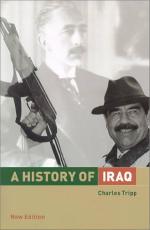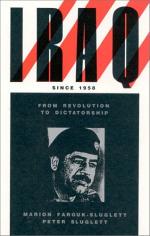Issue Date: May 2, 2003
Reviewed by FAITH J. CHILDRESS As the United States shifts its focus in Iraq from invasion to rebuilding infrastructure and filling the political vacuum left by the fall of Saddam Hussein’s regime, now is an opportune time to catch up on the history of colonialism and authoritarian rule that typifies Iraq’s political history. Charles Tripp’s second edition of A History of Iraq is the most recent (2002) and Peter Sluglett’s third edition of Iraq Since 1958: From Revolution to Dictatorship -- coauthored with the late Marion Farouk-Sluglett -- was published in 2001.While both volumes are readable, detailed and updated, readers who want a general overview of Iraqi history will find A History of Iraq the better choice. Iraq Since 1958, on the other hand, is an excellent volume for readers who are interested in the role of communism in Iraq and who want a more detailed account of the rise of the Baath Party and Saddam Hussein’s regime. The British created Iraq in 1920 out of three Arab provinces, Mosul, Baghdad and Basra, which had been part of the Ottoman Empire until its defeat in the First World War. Britain, as the European power in charge of the new nation-state, established a monarchy and chose the first king, Faysal. Iraq became independent in 1932, but Britain continued to maintain military and political influence with an eye toward protecting its interests in the oil industry. Iraq’s population of approximately 25 million is ethnically and religiously diverse. The majority are Arabs and Shiite Muslims. The ruling classes have traditionally belonged to the minority Arab Sunni Muslims. The non-Arab Kurds (about 20 percent of the population) are mostly Sunni Muslims. The Baath Party, which came to power briefly in 1963, has controlled Iraqi politics since 1968. Saddam Hussein, a member of the Baath Party, became president in 1979. Under his leadership, Iraq has fought with two neighbors: Iran (with Iraq enjoying Western support) from 1980-88 and Kuwait (1990-91). The latter war and the sanctions that followed it brought Iraq into conflict with the West and the United States. Tripp’s book begins with the 1831 reconquest of Iraq by the Ottoman Empire and ends with Iraq’s attempts to repair damaged relations with Kuwait and Saudi Arabia in 2001 and 2002. Throughout the book, Tripp examines three themes: the use of patrimonial links by various Iraqi regimes to maintain power, the effect of oil on the political economy, and the use of violence in achieving political goals. Tripp is concerned too with how the various governments have constructed the narrative of Iraqi history so that “their account alone . . . become[s] both the prism through which all Iraqis must see their country and the measure used to judge its rulers.” The first four chapters deal with the history of Iraq under the Ottomans, the British, and the British-supported Hashimite monarchy. Chapter 5 discusses the turbulent first decade of the Iraqi republic, proclaimed after the overthrow of the monarchy by Col. ’Abd al-Salam Arif and Brigadier ’Abd al-Karim Qasim, on July 14, 1958. The next decade was characterized by plotting among military officers and the struggle between Baathist and non-Baathist elements. The politics of patronage Though the 1960s brought changing fortunes for the Baathist and non-Baathist elements, Tripp asserts that several aspects of Iraqi politics remained constant. The Iraqi people continued to be without popular representation in government, the political-military leadership assumed no responsibility toward the Iraqi people, and the system of power supported by patrimonial links continued as it had under the monarchy. All political leaders viewed the state as a vehicle through which patrimonial links and coercive tactics could be manipulated in order to maintain power. The final third of the book is devoted to the rise of the Baath Party and the advent of Saddam Hussein’s rule. The Baath Party had spent much of the1960s agitating against the government because of its weak response to the 1967 Arab-Israeli war, which resulted in a humiliating Arab defeat. In July 1968, in conjunction with non-Baathist military officers, the Baath led a coup against president ’Abd al-Rahman ’Arif. A few weeks later, on July 30, 1968, the Baathists eliminated the non-Baathist leaders and established their own government. Originally in the background, Saddam Hussein emerged as the strongman, later ascending to the presidency. Tripp’s exposition of Saddam Hussein’s regime, including a discussion of how Saddam has maintained power for nearly 25 years, best illustrate the book’s key themes. Tripp argues that Saddam has constructed a narrative of the state in which he portrays himself as leader, benefactor, and a bulwark against external threats, and in which increasingly it is difficult to imagine the state without Saddam Hussein. Saddam has worked “to impose a political unity on Iraq that found its expression chiefly in his own person. Obedience to him was to be the common cause of Iraq’s heterogeneous inhabitants.” Saddam Hussein also worked to create an Iraqi national identity that emphasized Iraqi Arabness and a view of the state that portrayed it as protector of that unique identity against potential threats. Even when dealing with the majority Shiite population, Saddam stressed that Iraqi Arab Shiites were somehow more authentic than their non-Arab coreligionists in Iran. The spread of the Baath Party organization throughout Iraq, universal conscription to expand the military, the creation of paramilitary groups, and the establishment of a parliament soon after his ascendancy as president all combined to form ever-widening circles insulating Saddam from potential challengers. Saddam Hussein survived when all the evidence suggests that his political leadership should be in peril. Neither his mistakes of the 1980s during the Iraqi-initiated eight-year war against Iran, nor his “spectacular miscalculation” in planning the Iraqi invasion of Kuwait, nor the ramifications of the first Gulf War in the 1990s brought him down. The reasons for this are Saddam’s reliance on “small groups of men” who are linked with him either by “common regional background, family or tribal affiliation, or tried and tested dedication to his personal service.” Each of these associates, in turn, represent webs of patronage that totals some half-million persons that make up much of the support scaffolding for Saddam’s regime. The key to the relative success of the support network has been that the fortunes of all involved rely on the survival of Saddam Hussein himself to continue doling out the favors financed by Iraq’s oil revenues. In sum, Tripp attributes the resilience of Saddam Hussein’s regime to a “clannish and personalized system . . . based on patronage and inclusion of selected individuals and groups from known communities.” Saddam has kept serious, sustained internal challenges to his power at bay by keeping all except the most trusted groups away from state power structures and institutions. Tripp’s book includes a chronology, a glossary of Arabic terms, and three maps. All of these help complement the text by orienting the reader to key names, dates and locations. Though the reader can sort out the multitude of acronyms in the text by referring to the chronology, a separate list of these would have made the task easier. In addition to the bibliography, Tripp includes a list of sources detailing principle archival and secondary sources, many of which are in Arabic. War and economy Originally published in 1987, the volume by Marion Farouk-Sluglett and Peter Sluglett focuses on Iraqi history after the July 1958 revolution that ended the monarchy. Chapters 2 to 6 analyze the frequent regime changes until the advent of Saddam Hussein as the strongman. Chapter 7 is devoted to “Economy and Society since 1958.” In it the authors explain not only the value of oil to the Iraqi economy but also the role of the private sector. Chapter 8 deals with the effects on Iraq of the Iran-Iraq War, particularly the expansion of the private sector into businesses that had previously been run or controlled by the state. Finally, Chapter 9, added since the book’s second edition, discusses the results of Iraq’s 1990 invasion of, and subsequent expulsion from, Kuwait. The notes and the bibliography have been updated and include a wealth of Arabic and English primary and secondary sources. Unfortunately, a few typographical errors slipped into print, but these do not detract from the text as a whole. Farouk-Sluglett and Sluglett devote much space to the chronicling of the role of the Iraqi Communist Party, portraying it as having been perhaps the best representative of the interests of the Iraqi people in the face of a monarchy supported largely by imperialist ties. From late 1958 to mid-1959, subsequent to the overthrow of the monarchy, the party reached the zenith of its popularity and influence through the party structure and a number of related organizations. Political fortunes waned in President Qasim’s last years and after the Baathists executed a coup (and Qasim) in July 1963, the Iraqi government began “a relentless campaign . . . against the communists” that resulted in the “severe weakening” of the party. The authors characterize not only the monarchy, but also the non-Baathist and Baathist regimes that followed the 1963 coup as regimes that focused more on remaining in power than on developing channels through which people could voice their demands. While the Iraqi Communist Party recovered somewhat in the1960s and ’70s, it, along with all other parties such as the Shiites and Kurds and other non-Baathists, became the target of a sweeping crush of government opposition in 1978. The authors date the beginning of the “personality cult -- and ultimately, dictatorship -- of Saddam Hussein” from this time. Western involvement in Iraq Whereas Tripp focuses on the domestic patrimonial support networks that have made Iraqi regimes able to function as security states, Farouk-Sluglett and Sluglett spread the blame around, particularly in the case of Saddam Hussein. The authors argue that while Saddam Hussein remained in power specifically for reasons of personal power and gain, the West helped him maintain power through financial and military support, while the Iraqi people have suffered: “It is a tragic irony that the West and others have made him so invincible.” The final chapter looks ahead to the possible outcomes of a post-Saddam Iraq. Rejected is the idea that Turkey will claim the Kurdish region in northern Iraq and that Iran will snatch the Shiite-inhabited south. The authors acknowledge, however, that it seems unlikely the Kurds, having enjoyed more than a decade of effectively autonomous rule will “consent to return to the control of Baghdad.” Castigating the United States and its allies for their failure to remove Saddam during the first Gulf War, Farouk-Sluglett and Sluglett make a final assertion: “The introduction of democratic accountability and the rule of law in an Iraq after Saddam Hussein will act as powerful factors for national integration: The longer this is delayed, the harder the achievement of that integration will be.” These words were written before the United States’ war with Iraq began in March. Readers will be witnesses to the extent to which the Iraqi people achieve “national integration” and begin to write their own narrative of Iraqi history. Taken together, Tripp and Farouk-Sluglett and Sluglett’s works point toward two general conclusions about the political future of Iraq: First, it is unlikely that any Iraqi government will be entirely free from the network of kinship, tribal and associative ties that have supported Iraqi regimes thus far, and second, it is equally unlikely that the Iraqi population, whose political voices have been suppressed for so long, will accept a U.S.-appointed (or anointed) government in anything but an interim leadership role. Faith J. Childress is an assistant professor of history specializing in the modern Middle East at Rockhurst University in Kansas City, Mo. National Catholic Reporter, May 2, 2003 |

